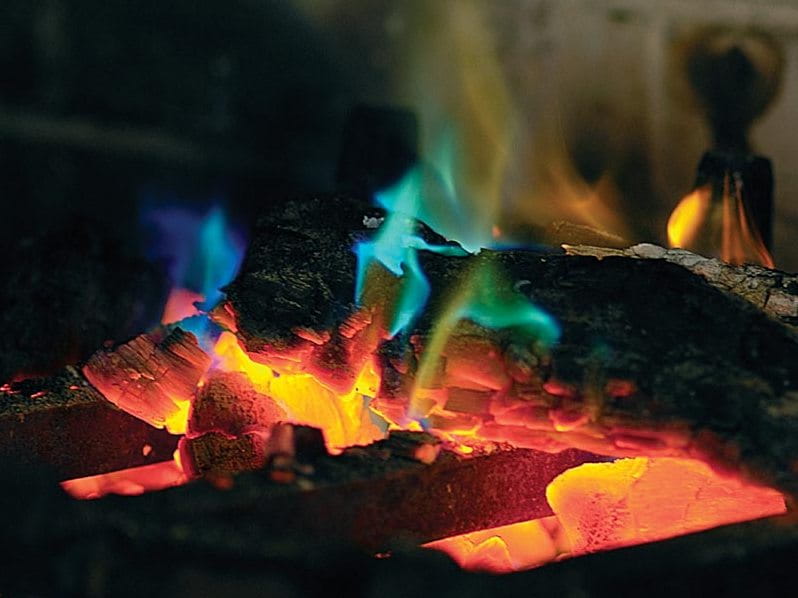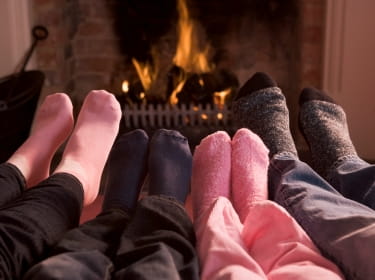Fireplace Perils

The Bottom Line
Fireplace flame color enhancers may contain heavy metals and/or caustic agents. Fire gel starter may contain methanol or hydrocarbons; both are toxic in small quantities. Fires can release poisonous carbon monoxide into the air.

The Full Story
What could be better than a cozy fire on a cold winter's night? Before you stoke those flames, be aware of some potential poisons that could spoil your fun. Fireplace accessories have become very popular and are found in many homes. Products designed to create multicolored flames, or make lighting the fire easier, have become common. But what happens when children or pets get into these products? Would you know what to do?
Fireplace flame color enhancers come in crystal, stick and pellet form and also can be embedded in artificial fire logs. They are intended to intensify the appearance of the flame or add exotic color to the flame in the fireplace or fire pit. When used as directed, they can be a safe and fun way to add enjoyment to your evening. When swallowed by kids or pets, they can cause injury and poisoning. Some of these products contain heavy metals such as lead, arsenic, and thallium. Heavy metals can cause damage to multiple organs, but are especially toxic to the brain. Other products contain caustic ingredients that can cause chemical burns if swallowed. This can cause immediate damage to the esophagus and stomach. Long term problems may include trouble swallowing and eating due to scar tissue formation.
Gel or liquid fire starters can be very dangerous when swallowed by small children. Several different types of poisons may be present in these products. Some contain methanol, which is the poison also found in windshield washer fluid. Swallowing this poison can lead to vomiting, drowsiness, confusion, permanent blindness, coma, and death. Other products contain hydrocarbons, which are oily substances often found in fuels and solvents. These chemicals are very slippery in nature and can easily go into the lungs when swallowed. If this happens, patients can have symptoms such as coughing, wheezing, and difficulty breathing. A chemical pneumonia can develop.
Prevent poisonings before they occur. Keep flame color enhancers and fire starters out of reach of small children. Barricade your fireplace when not in use so that children and pets do not find remnants of these products.
Also remember, carbon monoxide is formed whenever fire is present! Make sure your fireplace is clean and in good working order before lighting up this season. Most importantly - we just can't say this enough times: Make sure you have a carbon monoxide alarm installed near every sleeping area in your home. If you suspect a poisoning, call Poison Control right away at 1-800-222-1222. We're here to help 24 hours a day, 7 days a week.
Nicole Reid RN, BSN, MEd
Certified Specialist in Poison Information
Poisoned?
Call 1-800-222-1222 or
Prevention Tips
- Keep flame color enhancers and fire starters out of reach of small children.
- Barricade your fireplace when not in use so that children and pets do not find remnants of these products.
- Make sure to have a carbon monoxide alarm installed near every sleeping room in your home.
This Really Happened
A 9-month-old girl was found late one evening near a container of gel fire starter that had splattered on the floor. She had been alone for about 5 minutes. Her father didn't know if she swallowed any fire starter. It contained methanol and only a very small amount could cause dangerous poisoning. (Methanol can cause permanent blindness, coma, and death.)
Poison Control referred the child in to the nearest emergency room. She was given an antidote, fomepizole, to block the toxic by-product made by the body after methanol is swallowed. She was then admitted to the hospital for observation and to await the results of her blood methanol level. The following day the blood methanol level was found to be negative and she was discharged home with no ill effects.
References
Gummin, DD. Hydrocarbons. In Nelson LS, Lewin NA, Howland MA, Hoffman RS, Goldfrank LR, Flomenbaum NE. Goldfrank’s Toxicologic Emergencies. 9th ed. New York: McGraw Hill, 2011.Tomaszewski, C. Carbon Monoxide. In Nelson LS, Lewin NA, Howland MA, Hoffman RS, Goldfrank LR, Flomenbaum NE. Goldfrank’s Toxicologic Emergencies. 9th ed. New York: McGraw Hill, 2011.
Wiener, S. Toxic Alcohols. In Nelson LS, Lewin NA, Howland MA, Hoffman RS, Goldfrank LR, Flomenbaum NE. Goldfrank’s Toxicologic Emergencies. 9th ed. New York: McGraw Hill, 2011.
Poisoned?
Call 1-800-222-1222 or
Prevention Tips
- Keep flame color enhancers and fire starters out of reach of small children.
- Barricade your fireplace when not in use so that children and pets do not find remnants of these products.
- Make sure to have a carbon monoxide alarm installed near every sleeping room in your home.
This Really Happened
A 9-month-old girl was found late one evening near a container of gel fire starter that had splattered on the floor. She had been alone for about 5 minutes. Her father didn't know if she swallowed any fire starter. It contained methanol and only a very small amount could cause dangerous poisoning. (Methanol can cause permanent blindness, coma, and death.)
Poison Control referred the child in to the nearest emergency room. She was given an antidote, fomepizole, to block the toxic by-product made by the body after methanol is swallowed. She was then admitted to the hospital for observation and to await the results of her blood methanol level. The following day the blood methanol level was found to be negative and she was discharged home with no ill effects.
